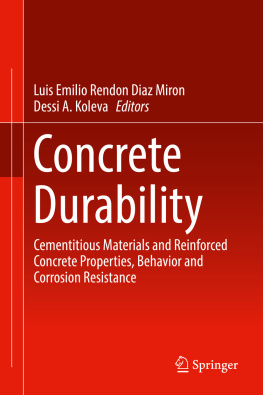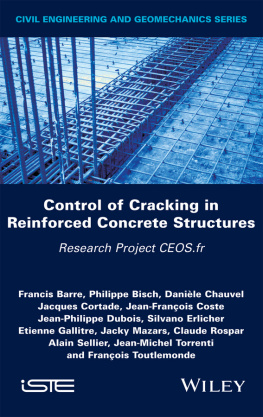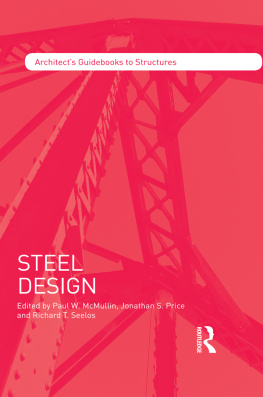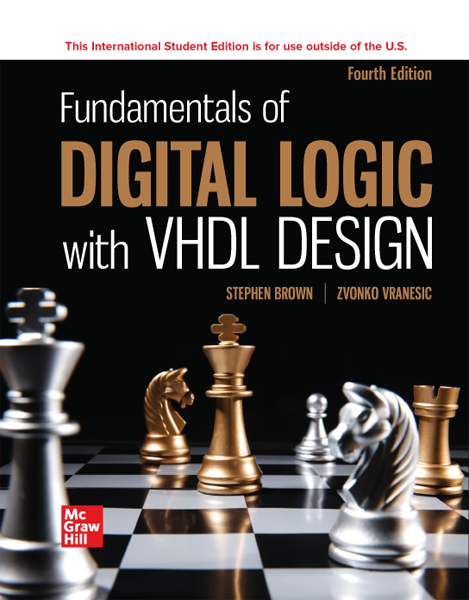
Page i
DESIGN of
CONCRETE
STRUCTURES
Sixteenth Edition
David Darwin
Ph.D., P.E., Distinguished Member of ASCE
Honorary Member of ACI, Fellow of SEI
Deane E. Ackers Distinguished Professor and Chair
of Civil, Environmental & Architectural Engineering
University of Kansas
Charles W. Dolan
Ph.D., P.E., Honorary Member of ACI
Fellow of PCI
H. T. Person Professor of Engineering, Emeritus
University of Wyoming


DESIGN OF CONCRETE STRUCTURES
Published by McGraw-Hill Education, 2 Penn Plaza, New York, NY 10121. Copyright 2021 by McGraw-Hill Education. All rights reserved. Printed in the United States of America. No part of this publication may be reproduced or distributed in any form or by any means, or stored in a database or retrieval system, without the prior written consent of McGraw-Hill Education, including, but not limited to, in any network or other electronic storage or transmission, or broadcast for distance learning.
Some ancillaries, including electronic and print components, may not be available to customers outside the United States.
This book is printed on acid-free paper.
1 2 3 4 5 6 7 8 9 LWI 24 23 22 21 20
ISBN 978-1-260-57511-8
MHID 1-260-57511-X
Cover Image: Courtesy of Michael G. Walmsley
All credits appearing on page or at the end of the book are considered to be an extension of the copyright page.
The Internet addresses listed in the text were accurate at the time of publication. The inclusion of a website does not indicate an endorsement by the authors or McGraw-Hill Education, and McGraw-Hill Education does not guarantee the accuracy of the information presented at these sites.
mheducation.com/highered
Page v

Page vi
6.3 ACI Code Provisions for Development of Tension
Reinforcement185
Page vii
9.15 Bar Splicing in Columns and Ties Near Beam
Column Joints307
Page viii
Page ix
Page x
Page xi
Page xii

Page iii
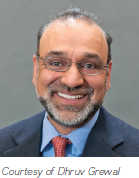
David Darwin has been a member of the faculty at the University of Kansas since 1974, where he has served as director of the Structural Engineering and Materials Laboratory since 1982 and currently chairs the Department of Civil, Environmental, and Architectural Engineering. He was appointed the Deane E. Ackers Distinguished Professor of Civil Engineering in 1990. Dr. Darwin served as President of the American Concrete Institute (ACI) in 20072008 and is a member and past chair of ACI Committees 224 on Cracking and 408 on Bond and Development of Reinforcement. He is also a member of ACI Committee 318 Building Code for Concrete Structures and ACI-ASCE Committee 445 on Shear and Torsion. Dr. Darwin is an acknowledged expert on concrete crack control and bond between steel reinforcement and concrete. He received the ACI Arthur R. Anderson Award for his research efforts in plain and reinforced concrete, the ACI Structural Research Award, the ACI Joe W. Kelly Award for his contributions to teaching and design, the ACI FoundationConcrete Research Council Arthur J. Boase Award for his research on reinforcing steel and concrete cracking, and the Concrete Research Council Robert E. Philleo Award for concrete material research and bridge construction practices. He has also received a number of awards from the American Society of Civil Engineers, including the Walter L. Huber Civil Engineering Research Prize, the Moisseiff Award, and the State-of-the-Art of Civil Engineering Award twice, the Richard R. Torrens Award, and the Dennis L. Tewksbury Award, and has been honored for his teaching by both undergraduate and graduate students at the University of Kansas. He is past editor of the ASCE Journal of Structural Engineering. Professor Darwin is a Distinguished Member of ASCE, an Honorary Member of ACI, and a Fellow of the Structural Engineering Institute of ASCE. He is a licensed professional engineer and serves as a consultant in the fields of concrete materials and structures. He has been honored with the Distinguished Alumnus Award from the University of Illinois Civil and Environmental Engineering Alumni Association. Between his M.S. and Ph.D. degrees, he served four years with the U.S. Army Corps of Engineers. He received the B.S. and M.S. degrees from Cornell University in 1967 and 1968 and the Ph.D. from the University of Illinois at Urbana-Champaign in 1974.
Charles W. Dolan is a consulting engineer and emeritus faculty member of the University of Wyoming. At the University of Wyoming from 1991 to 2012, he served as Department Head from 1998 to 2001 and as the first H. T. Person Chair of Engineering from 2002 to 2012, for which he received the University of Wyomings John P. Ellbogen lifetime teaching award. A member of American Concrete Institute (ACI) Committee 318 Building Code for Concrete Structures for 17 years, he has chaired the Building Code Page iv Subcommittees on Prestressed Concrete and Code Reorganization. He has served as chair of the ACI Technical Activities Committee, ACI Committee 358 on Transit Guideways, and ACI-ASCE Committee 423 on Prestressed Concrete. A practicing engineer for over 40 years, including 20 years at Berger/ABAM, he was the project engineer on the Walt Disney World Monorail, the Detroit Downtown Peoplemover guideway, and the original DallasFort Worth Airport transit system guideway. He developed the conceptual design of the Vancouver BC SkyTrain structure and the Dubai Palm Island monorail. He received the ASCE T. Y. Lin Award for outstanding contributions to the field of prestressed concrete, the ACI Arthur R. Anderson award for advancements in the design of reinforced and prestressed concrete structures, and the Prestress/Precast Concrete Institutes (PCI) Martin P. Korn award for advances in design and research in prestressed concrete. An Honorary Member of ACI and a Fellow of PCI, he is internationally recognized as a leader in the design of specialty transit structures and development of fiber-reinforced polymers for concrete reinforcement. Dr. Dolan is a registered professional engineer and lectures widely on the design and behavior of structural concrete. He received his B.S. from the University of Massachusetts in 1965 and his M.S. and Ph.D. from Cornell University in 1967 and 1989.
Page xiii

The sixteenth edition of Design of Concrete Structures continues the dual objectives of establishing a firm understanding of the behavior of structural concrete and of developing proficiency in the methods of design practice. It is generally recognized that mere training in special design skills and codified procedures is inadequate for a successful career in professional practice. As new research becomes available and new design methods are introduced, these procedures are subject to frequent changes. To understand and keep abreast of these rapid developments and to engage safely in innovative design, the engineer needs a thorough grounding in the fundamental performance of concrete and steel as structural materials and in the behavior of reinforced concrete members and structures. At the same time, the main business of the structural engineer is to design structures safely, economically, and efficiently. Consequently, with this basic understanding as a firm foundation, familiarity with current design procedures is essential. This edition, like the preceding ones, addresses both needs.
Next page


